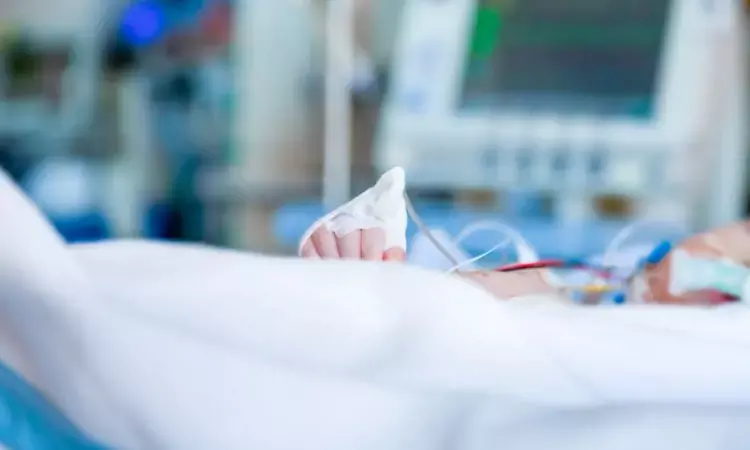- Home
- Medical news & Guidelines
- Anesthesiology
- Cardiology and CTVS
- Critical Care
- Dentistry
- Dermatology
- Diabetes and Endocrinology
- ENT
- Gastroenterology
- Medicine
- Nephrology
- Neurology
- Obstretics-Gynaecology
- Oncology
- Ophthalmology
- Orthopaedics
- Pediatrics-Neonatology
- Psychiatry
- Pulmonology
- Radiology
- Surgery
- Urology
- Laboratory Medicine
- Diet
- Nursing
- Paramedical
- Physiotherapy
- Health news
- Fact Check
- Bone Health Fact Check
- Brain Health Fact Check
- Cancer Related Fact Check
- Child Care Fact Check
- Dental and oral health fact check
- Diabetes and metabolic health fact check
- Diet and Nutrition Fact Check
- Eye and ENT Care Fact Check
- Fitness fact check
- Gut health fact check
- Heart health fact check
- Kidney health fact check
- Medical education fact check
- Men's health fact check
- Respiratory fact check
- Skin and hair care fact check
- Vaccine and Immunization fact check
- Women's health fact check
- AYUSH
- State News
- Andaman and Nicobar Islands
- Andhra Pradesh
- Arunachal Pradesh
- Assam
- Bihar
- Chandigarh
- Chattisgarh
- Dadra and Nagar Haveli
- Daman and Diu
- Delhi
- Goa
- Gujarat
- Haryana
- Himachal Pradesh
- Jammu & Kashmir
- Jharkhand
- Karnataka
- Kerala
- Ladakh
- Lakshadweep
- Madhya Pradesh
- Maharashtra
- Manipur
- Meghalaya
- Mizoram
- Nagaland
- Odisha
- Puducherry
- Punjab
- Rajasthan
- Sikkim
- Tamil Nadu
- Telangana
- Tripura
- Uttar Pradesh
- Uttrakhand
- West Bengal
- Medical Education
- Industry
Novel technique help in early identification of laryngeal clefts in infants: Study

Taiwan: Routine use of a novel technique of flexible endoscopy with noninvasive ventilation (NIV) and sustained pharyngeal inflation (FE-NIV-SPI) can help in the early detection of laryngeal clefts in infants, indicates a new study. The study was published in the journal Pediatric Pulmonology on 20 May 2022.
Laryngeal cleft (or laryngotracheal cleft) is an abnormal opening that occurs between the larynx and the esophagus through which the passage of food and liquid occurs through the larynx into the lungs. It causes several eating and breathing problems.
Considering the above, Wen-Jue Soong, Department of Pediatrics, Taipei Veterans General Hospital, Taipei, Taiwan, and colleagues reported a novel technique of flexible endoscopy with noninvasive ventilation and sustained pharyngeal inflation in assessing aeroesophageal tracts (AET) to facilitate early detection of laryngeal clefts in infants.
For this purpose, the researchers retrospectively reviewed and analyzed medical charts and flexible endoscopy videos of the children diagnosed with a laryngeal cleft in a tertiary care hospital between January 2000 and December 2020. All children had the technique applied to them.
The findings of the study were as follows:
- A total of 12 infants with laryngeal cleft were identified. This equates to a prevalence of 0.28% in all the children who underwent flexible endoscopy at the institution.
- Their mean age was 5.0 ± 4.9 months and mean body weight was 4.7 ± 2.3 kg. Nine (75%) infants were referred in without laryngeal cleft diagnosis, which was missed by 11 prior bronchoscopy and 5 computer tomography examinations.
- With the FE-NIV-SPI technique, the pharyngolaryngeal space could be pneumatically dilated permitting a detailed assessment.
- All laryngeal cleft types and coexisting AET lesions were visualized at the first FE-NIV-SPI examination with a mean time of 4.2 ± 0.9 min; they were eight Type I, two Type II, and one Type III.
- Ten (83.3%) infants had coexisting airway malacia.
The researchers wrote, "routine FE-NIV-SPI technique use can help to identify laryngeal clefts and other associated AET lesions early."
"Further multicenter collaborative investigations are essential to verify the early detection of this rare and occult lesion of the laryngeal cleft with this technique," they concldued.
Citation: Soong WJ, Tsao PC, Yang CF, Sung YH, Soong YH. Early detection of laryngeal cleft in infants by novel technique of flexible endoscopy with sustained pharyngeal inflation. Pediatr Pulmonol. 2022 May 20. doi: 10.1002/ppul.25988. Epub ahead of print. PMID: 35596199.
Dr Kamal Kant Kohli-MBBS, DTCD- a chest specialist with more than 30 years of practice and a flair for writing clinical articles, Dr Kamal Kant Kohli joined Medical Dialogues as a Chief Editor of Medical News. Besides writing articles, as an editor, he proofreads and verifies all the medical content published on Medical Dialogues including those coming from journals, studies,medical conferences,guidelines etc. Email: drkohli@medicaldialogues.in. Contact no. 011-43720751


